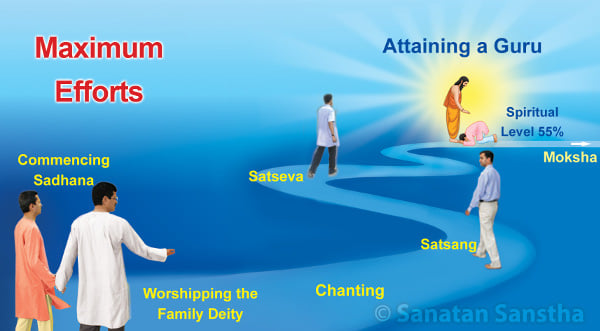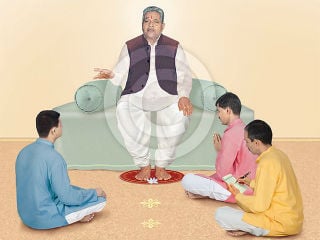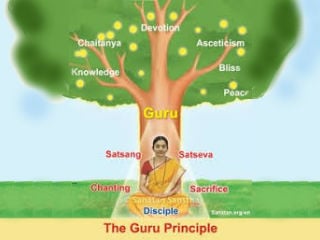Guru-Disciple tradition is a feature that sets Bharat apart from the rest of the world. This is our cultural heritage. The Guru guides His disciple spiritually and takes him upto discipleship and later, helps him attain Moksha (Final liberation).
So that the faith of the disciple in his Guru increases, his Guru’s Guru (meaning the Sadguru) and Sadguru’s Guru (meaning Paratpar Guru) guide him through the medium of his Guru. In the spiritual field today, the words ‘Guru, Sadguru and Paratpar Guru’ are used as synonyms; however, there is a marked difference between them in the spiritual context. Let us see how.
Who is a Guru ?

1. He who dispels a disciple’s ignorance, advises him to perform sadhana (Spiritual practice) and gets sadhana done through him so that he makes spiritual progress and bestows spiritual experiences upon him, is termed as Guru. Guru does not pay attention to the worldly happiness of His disciple (as this depends on his destiny). The Guru is attentive only to the disciple’s spiritual evolution.
2. The energy of the Supreme God to initiate (in sadhana) is the Guru.
3. Guru is the one who is not small, yet transforms the small into a large one (a Guru).
4. In the second chapter of the Holy text Sri Gurucharitra, the Guru has been called Vedadharma. Therefore, Vedadharma confers the status of Sadguru to only Him whose physical, verbal and psychological activities are harmonious with Vedas.
– H.H. Kane Maharaj (Narayangaon, Pune District, Maharashtra)
Saint and Guru
Saints do provide a little guidance for gaining some worldly and spiritual benefits. Some Saints work towards eliminating worldly problems of the people as well as their unhappiness due to distress from negative energies. This is the task of these Saints. When a Saint accepts someone as His disciple, He becomes the Guru for that disciple. A Guru provides complete guidance only for non-worldly matter, that is, attaining God. When a Saint functions as a Guru, He gradually loses interest in providing guidance for solving worldly problems of those who visit Him and later, such guidance ceases completely.
However, when He accepts someone as His disciple, He takes all-round care of that disciple. Every Guru is a Saint, but vice-versa is not true. Even then, most of the features of a Saint are also applicable to a Guru.
If we consider the spiritual level of an average individual to be 20% and that of God as 100%, then both Saint and Guru have a minimum spiritual level of 70%.
A Guru progresses faster than a Saint after a spiritual level of 70%. He reaches the next levels of 80% (Sadguru) and 90% (Paratpar Guru) respectively, earlier than a Saint would. The reason is that a Guru is always engrossed in His mission, that of spiritual progress of His disciple, while a Saint performs some worldly actions for the benefit of His devotees.
The unmanifest Guru pervades the entire Universe and is with us at all times during our life and even after we die. The salient and highlighting feature is that the unmanifest Guru stands by us throughout our life and slowly lifts us from our worldly life into a spiritual way of life. The Guru helps us develop skills such as perseverance, dedication, attention to detail, tenacity, compassion etc. through our lives.
What are the qualities in a Guru ?
1. One possessing spiritual knowledge
2. Having a yearning to impart spiritual knowledge to a disciple
3. Teaching only a disciple who will obey instructions
4. Teaching stepwise, based on a disciple’s spiritual level
5. Providing provocation to think
6. Examining the disciple’s homework
7. Avoiding answering unnecessary and worldly questions
8. Teaching with a positive attitude
9. Having equanimity towards all disciples
10. Protecting the disciple
11. Appreciating the disciple
12. Having the ability to get sadhana performed by the disciple
13. One without any expectation of receiving any Gurudakshina
14. Having a pure sattvik (Sattva-predominant) ego
Who is a Guru, Sadguru and a Paratpar Guru ?
Guru |
Sadguru |
Paratpar Guru |
|
| 1. Definition and Meaning | |||
| A. | Makes one aware of Maya and the Guru Principle | Bestows the spiritual experience of Self-realization and awareness that Brahman is all pervading |
Bestows the spiritual experience of non-duality (advait) |
| B. | Spiritual knowledge | Bestows initiation | Leads to Liberation |
| C. | Human form | God’s Name | Non-duality |
| 2. Spiritual level % | 70 | 80 | Above 90 |
| 3. His own anubhuti and those of others | Shakti (Energy) | Anand (Bliss) | Shanti (Peace) |
| 4. His own sadhana | Present | Present | Not necessary |
| 5. Attaining of Moksha | Possible | Easily possible | Has already occurred |
| 6. Site of the Kundalini | |||
| A. While guiding others | Anahat-chakra | Vishuddha-chakra | Sahasrar-chakra |
| B. During own sadhana | Adnya-chakra | Sahasrar-chakra | (No sadhana) |
| 7. Behaviour as per norms of the sect | Present | Present | (He is beyond sectarianism) |
| 8. Negative energy | |||
| A. Overcoming severe negative energy | Possible, but difficult | Possible | Easily possible |
| B. Method used for overcoming severe negative energy (possession, black magic etc.) | An action has to be performed | A resolve | Even a resolve is not required. In His presence, negative energy automatically disappears |
| 9. Conversation on | Spirituality | Spirituality | Any topic |
| 10. Miracles through | A prayer to God or to His Guru | A resolve | Supernatural powers and Deities perform miracles as service unto Him |
| 11. Mission | Making the disciple’s mind fertile | Sowing the seed of sadhana in the disciple’s fertile mind | Leading the disciple to non-duality |
| 12. Spiritual level % of disciple under Him | 55 | 70 | 80 |
| 13. Disciple’s sadhana | He tells the disciple to do sadhana | He gets the disciple’s sadhana done by mere resolve, without letting the disciple know | Disciple’s sadhana occurs automatically in His presence |

 The one and only Guru-disciple tradition of the Sanatan Sanstha which has proven special in...
The one and only Guru-disciple tradition of the Sanatan Sanstha which has proven special in... Who is proclaimed a Saint as per Science of Spirituality ?
Who is proclaimed a Saint as per Science of Spirituality ? Faith & Guru
Faith & Guru Who is a real Guru ?
Who is a real Guru ? The Guru Principle
The Guru Principle Offering gratitude unto the Holy feet of the Guru is true Gurudakshina !
Offering gratitude unto the Holy feet of the Guru is true Gurudakshina !